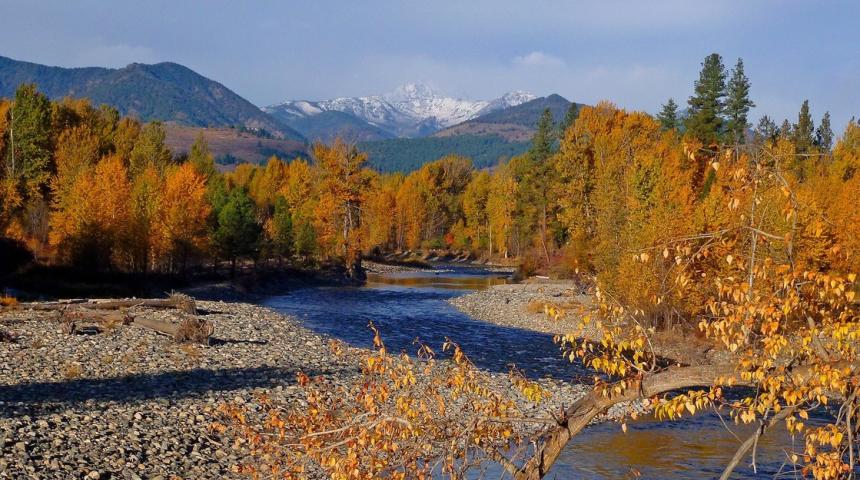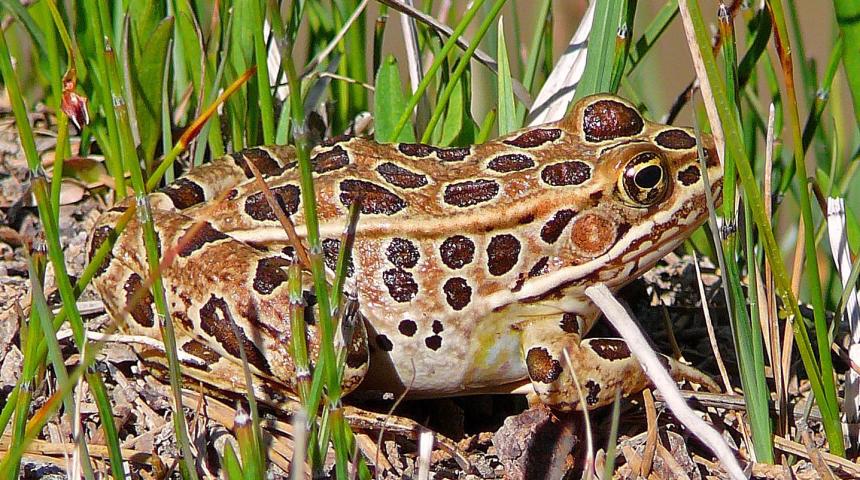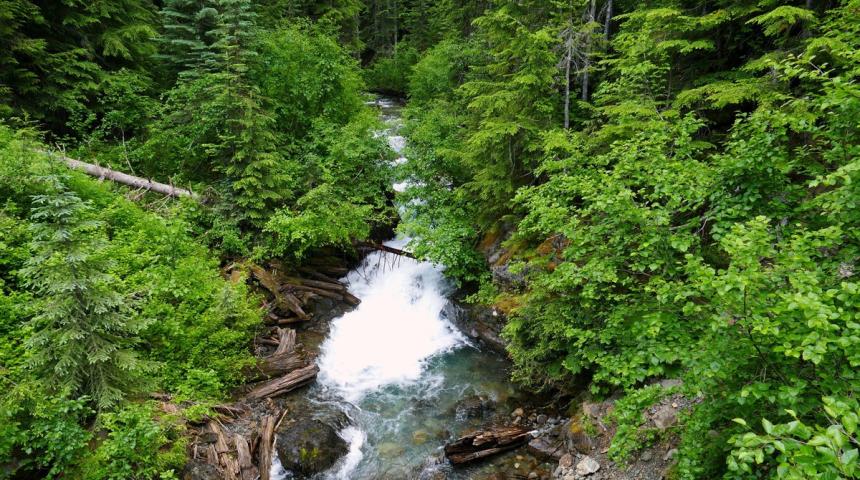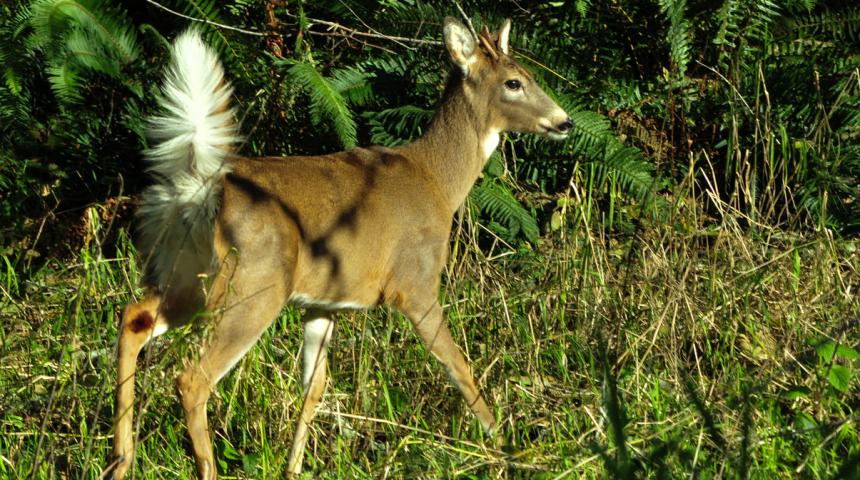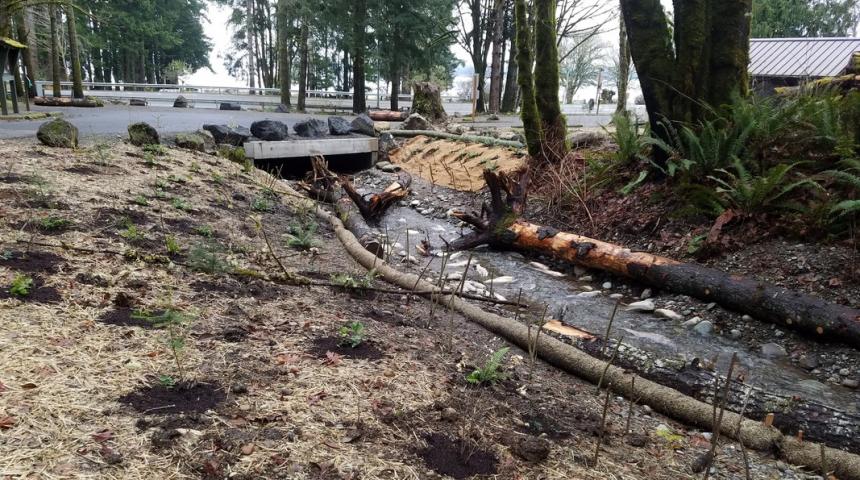Riparian areas contain elements of aquatic (water) and terrestrial (land) ecosystems. The interactions between water and land create an environment that is critical to the survival and existence of land-based and aquatic species. Known for their moist and mild microclimates, riparian areas have fertile soils that enhance plant growth and support complex food webs. Riparian areas are a critical resource as they directly benefit numerous wildlife species, including many that we in Washington cherish for their recreational and intrinsic values.
Description and range
Physical description
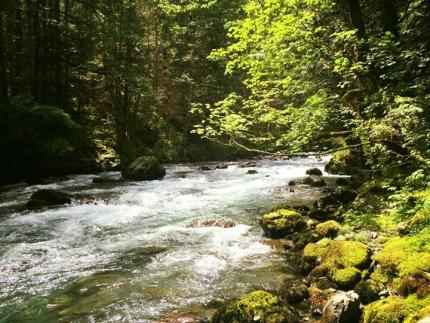
Riparian areas are unique because they are the transition between terrestrial (land) and aquatic (water) ecosystems. In general, riparian areas are along streams, rivers, and other flowing waterways. Because of their position on the landscape, riparian air temperatures are more moderate than surrounding areas and soils tend to be moist. Riparian plants are usually adapted to growing in wetter conditions. The linear shape of riparian areas makes them a natural corridor for animals to move through the landscape.
Geographic range
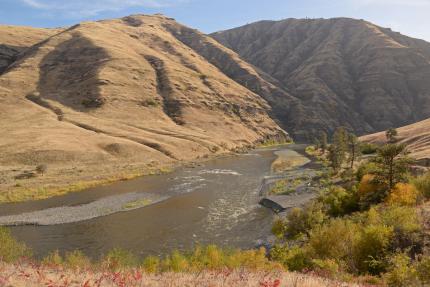
Riparian areas are along rivers, perennial or intermittent streams, seeps, and springs throughout Washington.
Species
Riparian areas provide a significant portion of Washington’s fish and wildlife habitat. In fact, more than three quarters of Washington’s land-based species use riparian areas as habitat. For this reason, riparian ecosystems are designated as a priority habitat. Many aquatic species, including fish and invertebrates, also depend on riparian areas as they influence instream habitat. This richness in biodiversity makes all riparian habitat a statewide conservation priority in Washington.
Plants
Riparian areas are widespread and come in a variety of forms. In Western Washington, they are mostly forested or densely vegetated. The most abundant and widespread westside riparian habitats occur in low elevation floodplains. In these lowland riparian systems, annual flooding creates a wide array of vegetation types, including woodlands, dense shrublands, wet meadows, and marshes. Lowland riparian ecosystems are usually dominated by hardwood (e.g., alder and cottonwood) and shrubs (e.g., red osier dogwood). Conifer trees begin to appear as riparian systems mature.
At higher elevations in Western Washington, riparian areas are more associated with steep and narrow headwater streams. Conifer trees, including fir, hemlock, and pine dominate these riparian areas, particularly at higher elevations, while poplar and alder are common in lower elevations.
Riparian systems in Eastern Washington vary in vegetation. In mountainous regions such as the Blue Mountains, Eastern Cascades, Okanogan Highlands, and Selkirk Range riparian areas feature shrubland vegetation at lower elevations with forested vegetation in higher elevation headwaters. In forested headwater riparian systems, common tree species include subalpine fir and Engelmann spruce.
Riparian vegetation in the Columbia Basin often shows a more abrupt change in appearance at their transition with nearby uplands. Trees and shrubs that require more moisture are confined to these riparian systems, which typically get their water from shallow groundwater or from intermittent soil saturation. Common trees in these systems include black cottonwood, white alder, and quaking aspen. Common shrubs include willow, red osier dogwood, snowberry, and mock orange.
Wildlife
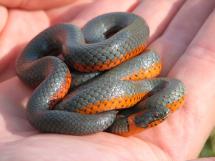
The moderate climate within riparian systems is one reason why these areas are an important part of the landscape. Many animals use riparian areas during hot summer months because water and dense vegetation create a cooler and more hospitable environment. This is true for many migratory birds as well as frogs and salamanders that are sensitive to extreme temperatures.
To avoid severe Eastern Washington winters, species such as the greater sage-grouse and Columbian sharp-tailed grouse require riparian areas because they often are warmer than surrounding uplands and are protected from harsh winds. Riparian areas also serve as major corridors for large migratory species such as elk and as shorter movement corridors for smaller mammals and amphibians.
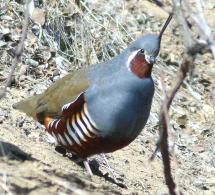
Although most aquatic species do not directly use riparian areas as habitat, riparian systems provide vital benefits to fish and other aquatic species. For example, riparian trees and other vegetation provide important shade, which cools streams, especially during hot summer months. This cooling effect indirectly benefits many of Washington’s salmon species that are not adapted to warmer waters.
Riparian areas can also create and change instream habitat in ways that benefit aquatic species. This often happens when large trees fall into streams, creating spaces for fish to find cover and shelter. These trees can also help form deep pools that serve as ideal spaces for adult fish to rest and for young fish to avoid predators. Riparian areas also benefit aquatic life by filtering pollutants before they can enter the stream.
Species of Greatest Conservation Need
Species of Greatest Conservation Need (PDF) include species that are state listed as sensitive, threatened, or endangered, or federal listed as threatened or endangered, as well as additional species thought to need conservation attention. These species of greatest conservation need are the basis for the State Wildlife Action Plan, which is an effort to protect rare species while keeping common species common.
The plan links species of greatest conservation need to the specific habitats they depend on. To not only survive but thrive, these species require quality habitats.
The following list features Species of Greatest Conservation Need that depend on riparian habitats.
Amphibians
- Cascade torrent salamander
- Dunn’s salamander
- Northern leopard frog*
- Oregon spotted frog*
- Rocky mountain tailed frog
Birds
Invertebrates
- Brown juga (snail)
- Cascades needlefly
- Columbia clubtail (dragonfly)
- Columbia Oregonian (snail)
- Mann’s mollusk-eating ground beetle
- Meadow fritillary
- Puget Oregonian snail
- White-belted ringtail (dragonfly)
Mammals
Reptiles
* Indicates "at-risk" species, meaning the animal is state listed as sensitive, threatened, or endangered, or is federal listed as threatened or endangered.
At-risk wildlife
"At-risk" species include animals that are listed as sensitive, threatened, or endangered at the state or federal level. The following section highlights a few of the at-risk species that rely on riparian habitats at some point during their lives.
Columbian white-tailed deer (Odocoileus virginianus leucurus)
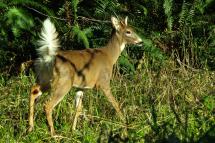
The Columbian white-tailed deer is listed as federally threatened along the lower Columbia River (Clark, Cowlitz, and Wahkiakum counties in Washington, and Clatsop and Columbia counties in Oregon). As of March 2020, an estimated 1,200 Columbian white-tailed deer live in this area.
This westernmost subspecies of white-tailed deer exists in small, isolated populations, rendering it vulnerable to such factors as disease and loss of habitat. This species also will be greatly affected by climate change because sea level rise will reduce this species' tidally influenced island and lowland habitats.
Did you know?
- Columbian white-tailed deer are only found in Washington and Oregon.
- In 1967, the Columbian white-tailed deer was part of a group of species that were the first to be granted federal endangered species protection.
- Adult females give birth to two fawns a year on average.
- WDFW and partners capture and move Columbian white-tailed deer to suitable locations within their range to bolster their populations.
Learn more about Columbian white-tailed deer.
Northern leopard frog (Rana pipiens)
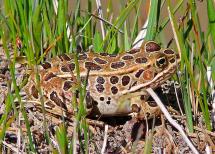
This frog is endangered in Washington. Only one known population remains -- in Grant County -- with limited information about population status and trends. Efforts are underway to determine the feasibility of translocations of these frogs to their former range.
Northern leopard frogs are semi-aquatic, requiring aquatic and terrestrial habitats. They are typically underwater (aquatic) during winter and on land (terrestrial) during the summer. The frogs require deep, well-oxygenated water that does not freeze solid for hibernation. These frogs are challenged by non-native vegetation and encroaching, native wetland vegetation that reduce the amount of exposed shoreline where they breed and forage. Northern leopard frogs may be preyed upon by many species throughout their life, but the most common are mustelids (weasel family carnivores), bullfrogs, and fish.
Did you know?
- The northern leopard frog is the only frog in Washington with round or oval dark spots arranged in irregular rows on its topside.
- Historically, this species was observed in seven Eastern Washington counties but is now only detected in one (Grant County).
- These frogs move across land, but little is known about their terrestrial movements in Washington.
Learn more about the northern leopard frog.
Columbian sharp-tailed grouse (Tympanuchus phasianellus columbianus)
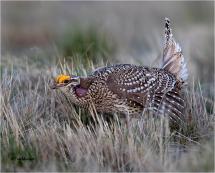
The population size of Columbian sharp-tailed grouse in Washington is low. Shortages of nesting, brood rearing, and wintering habitats are important factors limiting population recovery. Maintaining the species in Washington will require restoring habitat and increasing populations. The Columbian sharp-tailed grouse were the most abundant and important game bird in Eastern Washington during the 1800s. The current distribution of Columbian sharp-tailed grouse covers only about 2.8% of their historical range in Washington.
Did you know?
- In the spring, males gather on leks (traditional mating grounds) to dance and attract a mate. Males also inflate their purplish air sacs on the side of their neck to court females.
- Sharp-tailed grouse grow fleshy projections on their toes called pectinae that distribute the bird's weight as it walks across snow fields or other uneven terrain.
- In winter, these birds sometimes build tunnels in the snow for protection and to keep warm.
Learn more about Columbian sharp-tailed grouse.
Oregon spotted frog (Rana pretiosa)
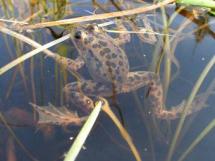
The Oregon spotted frog is a rare species in Washington. Stressors include wetland loss and alteration caused by humans or the natural process of wetland succession, the introduction of non-native/invasive species, and modifications of creek and river channels. Only six watersheds are known to contain Oregon spotted frogs. The species requires breeding sites in shallow water with short vegetation and full sun exposure.
WDFW partners with the U.S. Fish and Wildlife Service and Washington Department of Natural Resources to protect the Oregon spotted frog. Each year, biologists conduct frog egg mass counts to estimate the number of breeding adults and to better understand habitat use. Partners also include private landowners who actively manage their property to help preserve this rare frog.
Did you know?
- The English translation of their Latin name Rana pretiosa is “precious frog.”
- At its breeding site, a male frog’s mating call is a series of quiet, low-pitched knocks.
- The first female to lay her egg mass in suitable shallow water triggers frogs nearby to lay theirs next to hers, creating a communal deposit that may exceed 100 egg masses.
Places to explore
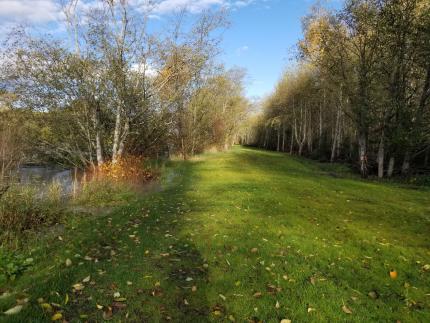
Washington’s wildlife areas provide habitat for fish and wildlife as well as land for outdoor recreation. Each year, thousands of people visit these areas to hunt, camp, hike, fish, and enjoy other outdoor activities. These activities support local economies and contribute to Washington’s wildlife-related recreation industry.
WDFW owns or manages nearly a million acres of land on 33 wildlife areas across the state. In addition to wildlife areas, WDFW also owns or manages hundreds of water access areas that provide boating or fishing access to lakes, rivers, and marine areas.
All visitors to WDFW lands need to display a current Discover Pass or WDFW Vehicle Access Pass. Annual and daily Discover Passes are available online at fishhunt.dfw.wa.gov or at license vendors across the state. Vehicle Access Passes are free with the purchase of most Washington hunting or fishing licenses.
Wildlife area unit
- Asotin Creek Wildlife Area Unit
The Asotin Creek Unit is comprised of grasslands and forests spread across portions of the North and South Forks of Asotin Creek, Charley Creek, and Lick Creek drainages. Diverse wildlife afford a variety of hunting and wildlife viewing opportunities for sportsmen, hunters, and nature enthusiasts.
- Beebe Springs Wildlife Area Unit
The Beebe Springs Unit covers 1 mile of Columbia River shoreline that includes riparian, wetland, upland shrubsteppe and cliff/talus habitats. This unit is easily accessible from Highway 97 just southeast of Chelan, and offers diverse opportunities for visitors, including an ADA interpretive trail, wildlife viewing along the Columbia River, and Frank's Pond, which provides fishing opportunities to anglers under 15 years of age.
- Rustlers Gulch Wildlife Area Unit
The Rustlers Gulch Unit provides a large contiguous area of healthy riparian and wetland habitats at low elevation, which is relatively unique in Eastern Washington and Pend Oreille County. The habitat supports many declining wildlife species populations such Townsend's big-eared bat, northern goshawk, western toad, Columbia spotted frog, and pygmy whitefish.
- Similkameen-Chopaka Wildlife Area Unit
The Similkameen-Chopaka Unit is known for trophy white-tailed buck deer. This unit is also a great place for birding, especially in the early spring. The steep mountain range to the west provides spectacular scenery, which also is home to bighorn sheep and mountain goats. The valley floor is mostly agricultural land, providing waterfowl forage. Ponds hold trumpeter swans, Canada geese and a variety of dabbling and diving ducks, while brushy riparian draws are a natural feature of the high water table, and provide habitat for upland birds as well as numerous migratory perching birds.
- Sunnyside Wildlife Area Unit
The Sunnyside Unit offers opportunities for waterfowl and upland game bird hunting and fishing along the Yakima River. Most of this unit is in the Yakima River floodplain. A collection of small agricultural fields interspersed with patches of native habitats, including nearly 13 miles of river shoreline support a variety of fish and wildlife.
- Nooksack Wildlife Area Unit
The Nooksack Unit of Whatcom Wildlife Area extends from the Nooksack River estuary north to WDFW's Tennant Lake Unit. Together these units protect the eastern bank of the Nooksack River from its mouth to Ferndale, as well as most of Tennant and Silver creeks. Native riparian vegetation and tidally influenced habitats are under restoration for salmon and waterfowl, and approximately 100 acres of corn is planted annually with 10 percent of the crop left standing as winter waterfowl forage. A 1.5 mile, dike-top trail offers walking opportunities along the Nooksack River.
- Union River Wildlife Area Unit
The Union River Unit at the inland terminus of Hood Canal, which is part of a larger complex of conservation and recreation lands that encompass Lynch Cove, the mouth of the Union River, and surrounding forested shorelines. The unit is managed for multiple uses, including birdwatching, nature study, waterfowl hunting, and estuary habitat restoration. This unit also features an interpretive trail.
- Cowlitz River Wildlife Area Unit
The Cowlitz River Unit offers bank fishing, birdwatching, and a boat launch. It is managed for black-tailed deer and riparian forest habitats. This unit has several large fields that are mowed and maintained as forage fields.
Other places to visit
- Billy Frank Jr. Nisqually National Wildlife Refuge
The Nisqually River Delta in Thurston County is a biologically rich and diverse area at the southern end of Puget Sound that supports a variety of habitats and wildlife. A walk on the Brown Farm Dike Trail takes visitors through riparian woodland and brush habitats.
- Columbia National Wildlife Refuge
The Columbia National Wildlife Refuge in Grant County has landscapes from the dramatic geologic processes of millions of years ago along with water from the present Columbia Basin Project that creates a stunning variety of habitats in this Eastern Washington desert. Popular trails include the mile-long Crab Creek (Loop) Trail that primarily follows Crab Creek, immersing one in its riparian habitat with scattered willows and large patches of wild rose and golden currant which attract a variety of birds.
- Conboy Lake National Wildlife Refuge
The Conboy Lake National Wildlife Refuge in Klickitat County includes a variety of native habitats that support a diverse wildlife community centered around the seasonally flooded Conboy Lake wet prairie habitat. The other habitats in the refuge include mixed conifer, upland meadow, ponderosa pine, emergent marsh, quaking aspen, Oregon white oak, and alder-willow dominated riparian that covers about 35 acres along the stream channels of the refuge.
- Turnbull National Wildlife Refuge
The Turnbull National Wildlife Refuge in Spokane County encompasses 18,217 acres of the Channeled Scablands. The refuge's diverse landscape — with over 3,000 acres of wetlands, 200 acres of aspen riparian areas, 10,000 acres of ponderosa pine forest, and 4,000 acres of prairie — supports a high diversity of wildlife species.
Conservation
Riparian is identified as a “Priority habitat” under the Priority Habitat and Species Program. Priority habitats are habitat types or elements with unique or significant value to a diversity of species.
A priority habitat may consist of:
- A unique vegetation type such as shrubsteppe or a dominant plant species such as juniper savanna;
- A described successional stage such as old-growth forest; or
- A specific habitat feature such as cliffs.
WDFW management tools
The Priority Habitat and Species Program is the Department's primary means of transferring fish and wildlife information from our resource experts to local governments, landowners, and others who work to protect habitat. This information is used primarily by cities and counties to implement and update land use plans and development regulations under the the Growth Management Act and Shoreline Management Act.
In the Department’s State Wildlife Action Plan “Habitats of Greatest Conservation Need (PDF)” chapter, riparian includes these ecological systems of concern: Columbia Basin Foothill Riparian Woodland and Shrubland; North Pacific Lowland Riparian Forest and Shrubland; and Northern Rocky Mountain Lower Montane Riparian Woodland and Shrubland.
The State Wildlife Action Plan is part of a nationwide effort by all 50 states and five U.S. territories to develop conservation action plans for fish, wildlife, and their natural habitats—identifying opportunities for species’ recovery before they are imperiled and more limited. A habitat of greatest conservation need is defined as an ecological system and community types that are essential to the conservation of Species of Greatest Conservation Need in Washington.
Conservation threats and actions needed
Climate change affects riparian systems through forces such as extreme precipitation and wildfire and through changes in seasonal inputs of water from rainfall and snowmelt. These changes are expected to increase the intensity of winter flooding and decrease summer stream flows.
Because riparian areas are directly linked to nearby waters, changes in stream flows also impact riparian ecosystems by altering soil moisture and the groundwater below riparian areas. In some watersheds, more extreme flooding events may increase the risk of erosion in riparian systems. Increased water temperatures, especially in summer, may also reduce the moderating influence that adjacent streams have on riparian microclimates. All these impacts influence the way riparian areas interact as fish and wildlife habitat in Washington.
Major threats to riparian habitat
- Conversion to roads and other development
- Grazing and agriculture
- Dams and diversions
- Invasive plants and animals
- Clearing and grading
Actions needed to maintain quality habitat
- Assemble multi-stakeholder groups to manage and monitor riparian areas.
- Carry out best management practices that focus on habitat conservation when grazing or farming near riparian management zones.
- Protect and maintain riparian ecosystem integrity by avoiding development, forestry, and other land use activities within riparian management zones.
- Identify areas that would benefit from enhancing, restoring, or reconnecting habitat and then implement measures that will improve lost or degraded habitat functions (e.g., control invasive plants, restore connectivity, floodplain restoration).
- Develop land use regulations through the Growth Management Act and Shoreline Management Act that conserve riparian areas and that strive for net ecological gains of riparian habitat and habitat functions.
- Make available programs to financially incentivize conservation, protection, and restoration of riparian areas.
Conservation efforts
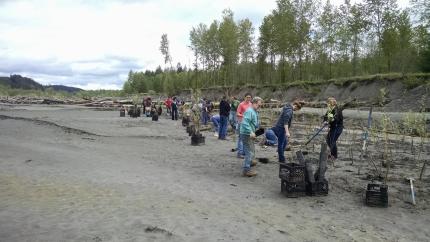
WDFW is involved in a variety of work to benefit riparian ecosystems and the species that use the habitat. These are a few projects we are doing with our partners to protect and restore riparian habitat across Washington.
Chehalis Basin Strategy
A changing climate is bringing extremes to the Chehalis Basin. In the last 50 years, there have been 14 federally declared disasters within the Basin. This, combined with human development and land use, have led to significant habitat loss and degradation over the past several decades. Salmon and other aquatic species have declined dramatically and face a dire future in the Basin. In response to this, the Aquatic Species Restoration Plan was designed to protect aquatic species and restore their habitats–now and in the face of climate change—and is a key component of the Chehalis Basin Strategy.
Learn how WDFW is participating in aquatic and riparian restoration projects in the Chehalis Basin.
Joseph Creek Riparian Restoration Project
In southeastern Washington, WDFW and the Asotin County Conservation District are sponsoring the Joseph Creek Riparian Restoration project. Joseph Creek, a tributary of the Snake River, has experienced higher stream temperatures than in nearby tributaries. Therefore, riparian habitat is being enhanced with vegetation along Joseph Creek. This project will help populations of Chinook salmon and steelhead by creating shade that will lower stream temperatures. Learn more about this project.
Yakima Beaver Relocation Project
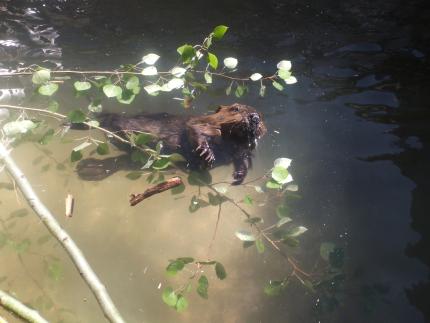
Beaver are a keystone species, creating habitat and influencing natural processes that many other species depend upon. WDFW collaborated with the Yakama Nation to relocate beavers that were a nuisance in urban and agricultural areas. Biologists trapped beavers and strategically relocated them to priority Yakima River tributaries. This relocation saved beavers from lethal removal and also helped improve fish habitat by restoring riparian function and improving water quality and hydrology.
Learn more about this project:
Get involved
Volunteer
- Register as a WDFW volunteer to help with activities that benefit fish, wildlife, and habitat.
- Join a Volunteer Advisory Committee to participate in the Washington State Recreation and Conservation Office’s grant programs that protect riparian areas.
Get involved in your community
- Provide input to your local government about development in riparian areas and its impacts to fish and wildlife species.
- For example: Take advantage of the public engagement opportunities afforded through Washington State’s land use planning frameworks, including the Growth Management Act. All towns, cities, and counties are required to protect critical areas, which include fish and wildlife habitat conservation areas.
- Contact a regional salmon enhancement group to learn about volunteer opportunities near you such as planting parties, vegetation monitoring and maintenance at restoration sites, and educational outreach at community events.
- Get involved with the Voluntary Stewardship Program if you are an agricultural landowner, producer, or other agricultural operator, and your county participates.
- Consider a landowner conservation agreement with the Department of Natural Resources Riparian Easement Program Forestry.
- Reach out to your local habitat biologist or private lands biologist for ideas on how to conserve, protect, and restore riparian areas in your area.
Support public lands
- Buy a Discover Pass for yourself or as a gift. This parking pass provides access to recreation lands managed by WDFW, Washington State Parks, and Washington Department of Natural Resources; and purchasing the pass provides funding to those agencies.
- Recreate responsibly in the great outdoors, including following “Leave No Trace” principles.
Share your riparian experience
- Share your photos and observations of riparian wildlife species to help us monitor wildlife populations and habitat.
Resources
Wild Washington lesson plans
WDFW publications and guides
- Riparian Ecosystems, Volume 1: Science Synthesis and Management Implications (2…
This best available science focuses on riparian ecosystems and aquatic species. This document is a partial update of the 1997 publication called Management Recommendations for Washington’s Priority Habitats: Riparian. Riparian needs of terrestrial species will be updated in the future.
- Riparian Ecosystems, Volume 2: Management Recommendations (2020)
These recommendations represent WDFW’s guidance for the protection and restoration of healthy, intact, and fully functioning riparian ecosystems. They also include guidance for how land managers and land use regulators can use best available science to protect these ecosystems within the scope of their authority and/or ability.
- Site-Potential Tree Height Mapping Tool
This mapping tool provides site-potential tree height information at the parcel level statewide and is most applicable to areas alongside waterbodies – also known as the riparian ecosystem.
- Riparian Management Recommendations: 1997 version
This document contains statewide riparian management recommendations for both aquatic and terrestrial species based on the best available science. Riparian Ecosystems, Volume 1: Science Synthesis and Management Implications (2020) contains updated science for riparian needs of aquatic species. This 1997 document continues to be the best available science for riparian needs of terrestrial species.
- Management Recommendations for Washington's Priority Habitats and Species: Ripa…
This publication provides guidance for incorporating pollinator-friendly management and conservation practices into land use activities in riparian areas. Guidance is provided in the form of scientifically supported management recommendations and best management practices (BMPs).
Educational materials
- Ecosystems in Washington at-home educational resources
Learn what makes a healthy ecosystem and explore a variety of ecosystems in Washington in this collection of lessons and activities.
- Riparian flashcards
Students can use these printable flashcards to learn about the riparian ecosystem and the plants and animals that live there.
- STEM education and work-based learning
Explore science, technology, engineering, and math (STEM) resources and activities for students to learn more about the riparian ecosystem.
Other resources
- U.S. Geological Survey – Science to inform riparian ecosystem restoration and m…
Scientific resources related riparian habitat alteration and the principal drivers of these changes.
- Washington Forest Protection Association – Buffer zones preserve Washington’s c…
Information on how to protect riparian areas along streams during timber harvesting.
- Washington Association of Conservation Districts
Explore riparian restoration programs available in Washington.
- Riparian Management Zone Checklist for Critical Areas Ordinances
This checklist is designed to help local planners translate BAS-based recommendations into Critical Areas Ordinance (CAO) amendments.
- Riparian Management Zone Checklist for Critical Areas Ordinances - Addendum
This addendum uses the same checklist format to provide citations to specific sections of existing CAOs as examples local planners may consider as part of the Fish and Wildlife Habitat Conservation Area (FWHCA) amendment process.
